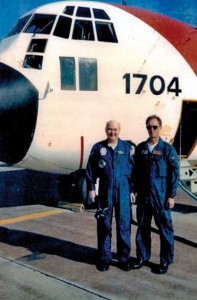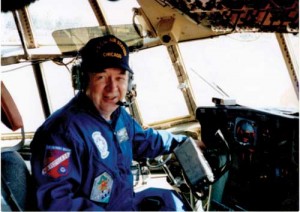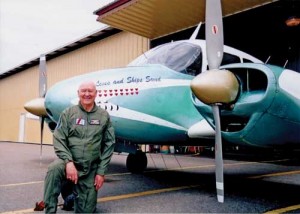Chicago’s lakefront was the start of it all. As a youngster, Joe Furman’s dad took him to see the Grumman Hellcats firing their 50 caliber machine guns into the lake on shore, from a hardstand at night. The stream of tracer bullets arched up into the night and you could see them hit the water from the light of the tracers. Airpower during World War II took on another meaning from that point on for Furman. As a Cub Scout, Boy Scout, and Explorer Scout, he learned the motto, “Be Prepared.” The Eagle Scout award was achieved. Furman’s life was based on this in everything he did after that.
In addition, a person experiences through athletics, the sense of not giving up, and finishing the race or making the goal line. As he looks back, every achievement had these foundation concepts.
In 1951, as a U.S. Naval Cadet at the University of Illinois, Furman learned how to operate a computer, repair it, and tie it into the big guns on a U.S. Navy Destroyer. He could not afford flight training, so he hung around the airport to do odd jobs. The Air Force gave him his opportunity. The instrumentation experience early in his life prepared him for the concepts needed later in flight training.
Over a period of years flying around the U.S. and the world, Joe Furman saw aviation as a life saving vehicle. Working during the day and attending school at night, he met people who had the same interest and together, they joined the U.S. Air Force Auxiliary (CAP) as a pilot. He then met a group at Palwaukee Airport in Wheeling/Prospect Heights, Illinois, who wanted to fly more.
The U.S. Coast Guard Auxiliary Aviation (Flotilla 3-8, 9W District) was formed and he purchased a Piper Apache and flew Search & Rescue concurrently for both organizations, in Illinois, Wisconsin, Michigan and the Great Lakes. The Apache became the longest flying twin-engine auxiliary aircraft the Coast Guard had, supporting every mission, except for hoisting, dropping material, and landing on water. The Apache saved 23 lives, two fishing trawlers, and four catamarans, and supported the U.S. Coast Guard Cutters on search and rescue (SAR) missions, ice breaking, pollution patrols, security missions, live fire exercises on the Great Lakes, and navigation and equipment checks, plus other specific assignments by the Coast Guard Command.

L/R) Joe Furman of the U.S. Coast Guard Auxiliary with a flight check team commander at U.S. Coast Guard Station-Sacramento, Calif.
As a district flight safety officer, check pilot and facility inspector, Furman’s travels took him across the United States. In addition, as an emergency medical technician (EMT) and medic, he saved a seaman on a mission in the Pacific aboard a C-130 out of Air Station Sacramento, California.
While volunteering for these organizations, Joe Furman worked full time as an internal auditor, financial manager, and controller, which took him around the world and across the United States. He then taught as a assistant professor in the Minnesota state college system, and then and presently in private practice, as a Certified Public Accountant.
Furman and his wife, Elizabeth, have 13 children, eight of which are serving or who have served in the U.S. Armed Forces. Three served in Iraq/Afghanistan at the same time. All have flown with Furman. His son, Michael, was with the Air Force A-10 squadron out of New Orleans, and his son, Joseph, was with the U.S. Marine Corps aviation program. Furman’s son, Andrew, was with the Minnesota National Guard 147th Air Assault Battalion, and his daughter, Christine, was a technician onboard a C-130 gunship. Furman’s son, Marc, was with the U.S. Rangers, and his son, Brian, was a military policeman (MP) at Ft. Bliss. His son, Edmond, was with the 82nd Airborne out of Fort Bragg.
While on standby at the airport in Waukegan, Illinois, Furman and his colleague, Bob Beyer, received a call that a fishing boat was overdue off the western shore of Lake Michigan, and that a shoreline search was started by the U.S. Coast Guard facilities. The 35 kts wind was out of the southwest and seas were at 8 to 10 feet with whitecaps. Byer had been a tank commander under General Patton in the “Battle of The Bulge,” and a crewman with Furman on most of his flights. At that time, they plotted their SAR pattern based upon Furman’s SAR school training, and previous SAR experience. This took them out 45 nautical miles to the center of Lake Michigan where Furman spotted the boat.
The vessel had drifted and taken on water. Two people were bailing water and two were on the bridge waving their shirts. Furman radioed his position, gave a description of the situation, and they radioed back and said, “we’re looking for BIG MAMA.”
Making a tight pass at the ship’s stern, Furman said: “I have a BIG MAMA taking on water. The boat is half underwater, there’s four persons on board, and I need an immediate rescue boat with pumps at this fix.”
The water was 45 degrees Fahrenheit and survival may be at most 35 minutes in the water. Furman managed to guide the rescue boat from shore, and when the captain got there, he said, “You wouldn’t find four happier people in the world here. There were two doctors and their teenage sons who started out fishing that morning. We found them at 7 pm that evening. Four lives saved and a 48 ft fishing trawler named BIG MAMA was saved
Ed Limp and Furman were on standby at the Waukegan base one Sunday at noon, when they received a call that four catamarans with three people aboard each, were overdue and not heard from on a race from Michigan City to the Chicago/Milwaukee area.
Furman and his crew started in good weather, but then out over the lake, the weather turned ugly.
“I dropped to 300 feet off the deck and based upon my estimate of the conditions, and the capabilities of the vessels, I plotted a probable course,” said Furman. “We found one vessel with one person hanging over the side, with no PFDs, and two aboard trying to keep the vessel upright. We radioed their position and figured the other three may be nearby based on the wind direction and seas.”
Sure enough, Furman found the other three catamarans, each with three people on board in the same circumstances. Furman radioed his position, rescues were completed, and he headed back to the airport to a welcoming committee. Twelve (12) lives and four catamarans saved. All in a day’s work.
EDITOR’S NOTE: Joe Furman holds a Commercial Pilot Certificate, Instrument Instructor, Ground, Advanced Instrument Instructor, Multi-Engine Land, and Single-Engine Land and Sea.
Furman was rated with the U.S. Coast Guard Auxiliary as an aircraft commander, pilot examiner, facilities inspector, district flight safety officer, instructor, emergency medical technician, and flotilla commander. He received an honorary captain rating in the DC-9 simulator a few years ago from Northwest Airlines. Currently, Furman is flying everything he can get his hands on that he is qualified to fly. Furman continues to fly the Piper PA-23 Apache that he has owned for 37 years. Furman also owns a Piper Colt PA-22. He resides in Cold Spring, Minnesota.












